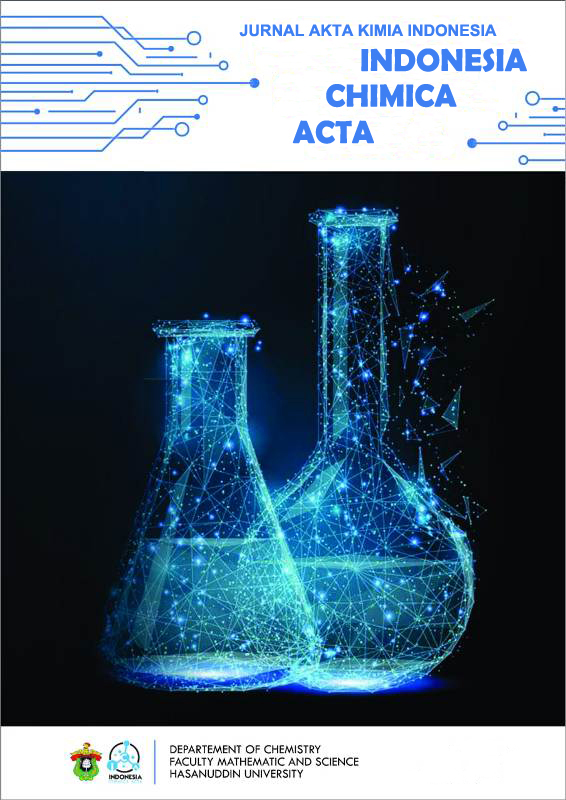Synthesis and Characterization of Rise Husk Nanopores Carbon Through Ultrasonic Irradiation With H3PO4 Activators as Electrochemical Energy Storage Materials
Abstract
Full text article
References
Chen, M., dan Lena, Q. Ma., 2001, Comparation of Three Aqua regia Methods for Twenty Florida Soils, Soil Science Society of America Journal, 65 (2); 491.
Daifullah, A.A.M., Girgis, B.S., dan Gad, H.M.H., 2003, Utilization of Agro-Residues (Rice Husk) in Small Waste Water Treatment Plans, Elseiver B.V., 57 (11); 1723–1731.
Houston, D.F. 1972. Rice Chemistry and Technology. Minnecosta: America Association of Cereal Ceramic. Inc.
Hu, C. C., Chang, K. H., an Lin, M. C., 2006, Design and Tailoring of the Nanoturbular Arrayed Architecture of Hydrous RuO2 for Next Generation Supercapasitors, Nano Letters, 6 (12); 2690-2695.
Ip, A.W.M., Barford, J.P., McKay, G., (2008), Production and Comparison of High Surface Area Bamboo Derived Active Carbons. Jounal Bioresources Technol., 99 (18); 8909-8916.
Izadi, N. A., Yamada, T., Futaba, D. H., Yudasaka, M., Takagi, H., Hatori, H., dan Hata, K., 2011, High-Power Supercapacitors Electrodes from Single-Walled Carbons Nanoborn/Nanotube Composite, ACS Nano., 5 (2); 811-819.
Jaya, A.T., Ariwibowo, D.S. 2002. Effects of Addition of Rice Husk Ash on Expansive Soils. Http: //dewey.petra.ac.id/jiunkpe_dg_201. Accessed on July 28, 2015..
Lee, E., Shin, D., Kim, H., Koh, Y., dan Jang, J., 2008, Membrane of Hybrid Chitosan–Silica Xerogel for Guided Bone Regeneration, Biomaterials, 30 (5); 743-50.
Lin, J., Siddiqui, J.A., dan Ottenbrite, M., 2001, Surface Modification of Inorganic Oxide Particles with Silane Coupling Agent and Organic Dyes, PolymerAdvance Technology, 12; 285–292.
Narendra, R., and Susanti, 2012, Thesis: Electrochemical Capacitors from Tungsten Trioxide (WO3) Materials with Gel Cell Method and Calcination Process, Department of Materials and Metallurgical Engineering, Sepuluh November Institute of Technology: Surabaya.
Nasrullah, M., and Darminto, Phase Analysis and Width of Carbon Energy Band Gap in Coconut Shell Heating, Pomits Journal of Art and Science.
Simon, P., dan Burke, A., 2008, Nanostructured Carbons: Double Layer Capacitance and More, The Electrochemical Society Interface., 38-43.
Socrates, G. 1994. Infrared Characteristic Group Frequencies. England: The University of West London.
Stoller, M. D., Park, S., Zhu, Y., An, J., dan Ruoff, R. S., 2008, Graphene-Based Ultracapasitors, Nano Letters., 8 (10); 3498-3502.
Sun, Y.C., Chip, P.H., dan Shiue, M.Y., 2001, Comparison of different Digestion Methods for total Decomposition of Siliceous and Organic Environmentals Sample, Analytical Sciences, 17 (12); 1395-1399.
Svehla, G., 1985, Vogel Part II Textbook The fifth edition of Qualitative Inorganic Analysis of Macro and Semimicro, PT. Kalman Media Pustaka, Jakarta..
Wei, X., Xiao, Li., Jin Zhou, dan Ping, Z. S., 2011, Nanoporous Carbon Derived from Risk Husk for Electrochemical Capacitor Application, Advanced Materials Research, 239-242; 2101-2106
Widiantoro, A.T.T., and Susanti, D., 2013, Effect of Calcination Temperature Variations on the Capacitive Properties of Tungsten Oxide Electrochemical Capacitors (WO3) Sol Gel Synthesis Results, Technical Journal of POMITS, 2 (1); 3.
Zakir, M., 2013, Electrodeposition of Ru and Polyaniline Metals on Active Carbon Surfaces of Rice Husk by Ultrasonic Irradiation, Indonesia Chemica Acta, 6 (2); 2.
Zhu, Z., Hu, H., Li, W., dan Zhang, X., 2007. Resorcinol Formaldehyde Based Porous Carbon as an Electrode Material for Supercapasitors, Carbon, 45; 160-165.
Authors
This is an open access journal which means that all contents is freely available without charge to the user or his/her institution. Users are allowed to read, download, copy, distribute, print, search, or link to the full texts of the articles in this journal without asking prior permission from the publisher or the author.
Jurnal Akta Kimia Indonesia (Indonesia Chimica Acta) operates a CC BY-SA 4.0 © license for journal papers. Copyright remains with the author, but Jurnal Akta Kimia Indonesia (Indonesia Chimica Acta) is licensed to publish the paper, and the author agrees to make the article available with the CC BY-SA 4.0 license. Reproduction as another journal article in whole or in part would be plagiarism. Jurnal Akta Kimia Indonesia (Indonesia Chimica Acta) reserves all rights except those granted in this copyright notice.

